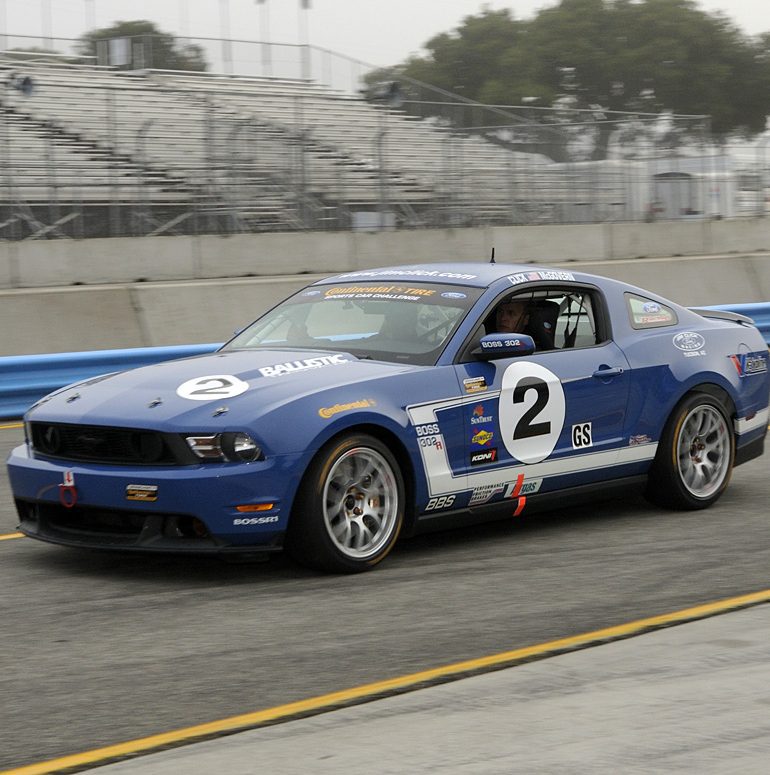2012 Ford Mustang Boss 302R
MONTEREY, Calif., Aug. 13, 2010 – It’s no secret that, near the end of 2009, Ford Racing announced the Mustang Boss 302R, a full-race, off-road-only vehicle complete with roll cage, race seats, safety harness, data acquisition, race dampers/springs and Brembo brakes. Since its first start at Daytona, the 302R has been proving itself to Ford engineers and the competition alike, with two pole positions in seven races so far this year.
What racing fans haven’t known is that the Boss 302R has also been serving as a very public test bed for the all-new road-going Mustang Boss 302, a car that, until recently, has been secret even to many people at the company.
“The old adage that ‘racing improves the breed’ held true as we were building the production Boss 302,” explains David Pericak, Mustang chief engineer. “Since the Boss 302R race cars used many of our planned production parts, we had the advantage of six months’ worth of racing telemetry to add to our standard battery of environmental tests pulled from the 2011 Mustang program. The track experience was helpful in identifying improvements we could make on the production Boss – particularly the Laguna Seca model – to provide a competitive race car right off the showroom floor.”
Identical parts, repeatable results
Collaborating with Ford Racing, the Mustang team decided if they were going to use the 302R for full-scale testing, then the race car would need to use planned production components to get valid data. As a result, engineers installed the first Boss 5.0-liter engine that came off the line directly into the 2011 302R development mule for track testing.
“The 302R engines come straight off our production line with the same short block,” explains Mike Harrison, Ford V8 engine program manager. “The forged pistons, stronger connecting rods and all the other refinements were already designed for racing, so it was straightforward to take what we learned on the track and apply it to the production car.”
The results using the initial engine design were encouraging, though the data pointed out potential concerns with both engine cooling and oil control. Specifically, the car needed more of both, so aerodynamic elements in the front of the car were revised to improve airflow efficiency.
Also, under the hood the Boss radiator was redesigned and plumbing changes were implemented to more effectively use the additional airflow the new fascia aero treatment was able to supply – all changes that have been implemented on standard production Boss models and the race-ready Laguna Seca cars.
Using software that plotted oil pressure at specific g loads and at particular parts of the track, engineers isolated the motions causing oil starvation. Based on the track telemetry, baffles were added in specific locations, eliminating the issue without adding any more weight than necessary.
To aid the brakes, an aggressive engine braking algorithm was employed in the powertrain control module (PCM) – the engine braking allows the driver to brake later in turns, reducing wear on the friction brakes. Brake cooling ducts from Ford Racing were found to dramatically improve fade resistance – the ducts became standard on the 302R and the Boss Laguna Seca, and are available over the counter for standard Boss models.
“Racing can serve as a technical proving ground for production cars,” said Jamie Allison, director, Ford Racing. “The 5.0-liter block and architecture in the Mustang Boss 302R is the same as the 2011 Mustang GT, and many of the 302R components and much of the engineering knowledge shared between our teams will soon be available to customers in the 2012 Mustang Boss 302. The tradition and the spirit of Boss, a car born for the track, remain today and you can bet more than a few Ford Racing employees will have a Boss 302 in the garage soon.”

In Detail
| type | Series Production Car |
| built at | Flat Rock, Michigan, USA |
| production | 1 |
| engine | 90º V8 |
| position | Front, Longitudinal |
| aspiration | Natural |
| block material | Aluminum |
| valvetrain | DOHC, 4 Valves per Cyl |
| fuel feed | Injection |
| displacement | 4951 cc / 302.13 in³ |
| bore | 92.2 mm / 3.63 in |
| stroke | 92.7 mm / 3.65 in |
| compression | 11.0:1 |
| power | 328.1 kw / 440 bhp |
| specific output | 88.87 bhp per litre |
| torque | 515.2 nm / 380 ft lbs |
| redline | 7500 |
| body / frame | Unitary Steel Monocoque w/Aluminum Hood |
| driven wheels | RWD |
| front brakes | Ventilated Discs w/4-Piston Flating Calipers |
| f brake size | 36 x 355 mm / 1.4 x 14.0 in |
| rear brakes | Ventilated Discs w/Single-Piston Flating Calipers |
| r brake size | 19 x 300 mm / 0.7 x 11.8 in |
| front wheels | F 48.3 x 22.9 cm / 19 x 9 in |
| rear wheels | R 48.3 x 24.1 cm / 19 x 9.5 in |
| f suspension | MacPherson Struts w/Coil Springs, Anti-Roll Bar |
| r suspension | Live Axle w/Coil Springs, Anti-Roll Bar |
| weight distro | 54.7 % / 45 % |
| wheelbase | 2720.3 mm / 107.1 in |
| length | 4777.7 mm / 188.1 in |
| width | 1877.1 mm / 73.9 in |
| height | 1399.5 mm / 55.1 in |
| transmission | 6-Speed Manual |
| gear ratios | 3.66:1, 2.43:1, 1.69:1, 1.32:1, 1.00:1, 0.65:1 |
| final drive | 3.73:1 |
Story by Ford Motor Company




